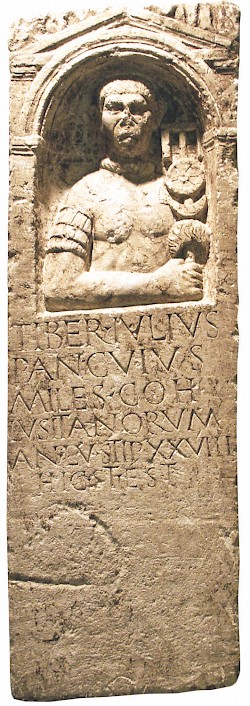Ancient Warfare at the museum - 2
 The tombstone depicted with this blog is printed in the upcoming issue of Ancient Warfare. It’s a memorial for an Iberian auxiliary in Roman service along the Rhine: Tiberius Julius Pancuius. The tombstone, measuring 161cm high and 53cm wide, is made of limestone from the Lorraine area in northern France. That’s a good distance from Neuss (Novaesium) on the Rhine in Germany, close to Cologne, where it was found in 1950. Most likely the stone was transported from a Lorraine quarry to the area via the Moselle and Rhine rivers, to be hewn into a ready-made grave marker at one of the workshops in the area. Stylistically it fits other stones found in the general Cologne-Bonn area. They were probably carved from standard examples perhaps with a little variety as instructed by the soldier himself, if he selected one for future use, or by his heirs.
The tombstone depicted with this blog is printed in the upcoming issue of Ancient Warfare. It’s a memorial for an Iberian auxiliary in Roman service along the Rhine: Tiberius Julius Pancuius. The tombstone, measuring 161cm high and 53cm wide, is made of limestone from the Lorraine area in northern France. That’s a good distance from Neuss (Novaesium) on the Rhine in Germany, close to Cologne, where it was found in 1950. Most likely the stone was transported from a Lorraine quarry to the area via the Moselle and Rhine rivers, to be hewn into a ready-made grave marker at one of the workshops in the area. Stylistically it fits other stones found in the general Cologne-Bonn area. They were probably carved from standard examples perhaps with a little variety as instructed by the soldier himself, if he selected one for future use, or by his heirs.
The text of the inscription reads: Tiber(ius) Iulius / Pancuius / mil(es) coh(ortis) / Lusitanorum / an(norum) LV stip(endiorum) XXVIII / hic s(i)t(us) est (Ness-Lieb 244), which reads in English as: Tiberius Julius Pancuius, soldier of the Cohort of Lusitanians, lived 55 years, served 28 years, lies here. The tria nomina suggests he was given his citizen rights by the emperor Tiberius, adding his own unique, original name as the third part of his new, formal Roman name. The fact that the tria nomina is fully given, the early date for the emperor, the sculpture style of the stone and the text of the inscription all suggest the stone dates to the early / middle first century AD. Moreover, the fact that he served 28 years instead of the later established 25/6 for an auxiliary soldier when their terms of service were formalized in the reign of Claudius, adds to that conclusion.
Pancuius served in the Cohors of Lusitanians, identified in full as the Cohors III Lusitanorum from other inscriptions from the area. It was probably raised by Augustus from troops in the western Iberian Peninsula (ie modern Portugal) and served in Germania Inferior, went south to the Alps during the Year of the Four Emperors, then back to Germania and subsequently to Pannonia Inferior. There is no trace of this unit after AD 167, which may indicate it disappeared during the Marcomannic Wars.
Finally, how did Pancuius choose to be displayed to posterity? The most striking feature of this stone is undoubtedly the standard held in Pancuius’ right hand. He’s not listed as signifer, which is at least odd, considering it’s a higher rank than the plain old miles he’s listed as. The standard seems to be a simple design with a crossbar, probably bearing the unit name, below a spike at the top, with streamers hanging down. Below that is a phalera, the roundel, and a lunula, the crescent (or perhaps two). We don’t know exactly what these mean. They might indicate unit decorations, or designate the centuria within the cohort. Pancuius himself is shown wearing a torque around his neck, which might be the Roman decoration, or a perhaps a tribal distinction. Considering how Pancuius uses his full Roman name without even a mention of his tribe, the former may be more likely. Though equipped with what seems to be helmet-hair, he does not seem to wear anything on his head, but his body is protected by some kind of armour. As always with these stones, it’s impossible to make out whether that depicts a smooth, musculed bronze or iron piece, or was painted to resemble chainmail, though it’s obviously worn over a subarmalis whose pteryges, the strips on his shoulders, are sticking out from under it. Undoubtedly Pancuius stone would’ve been painted in bright colors to attract attention to it, but that’s unfortunately worn off. But the fact it survives at all, allowing us to admire and learn from it is its own attraction.
